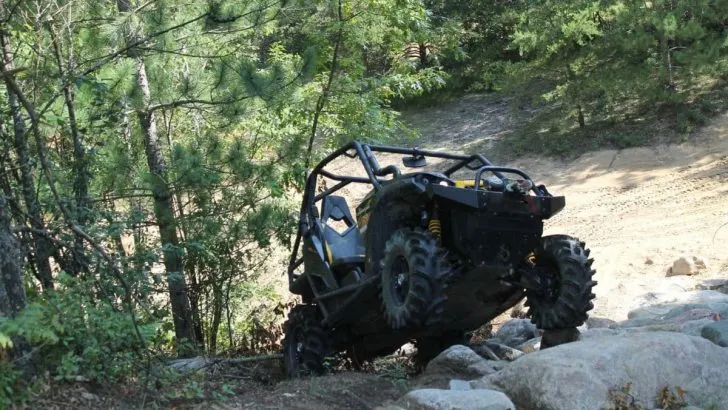The Polaris Ranger has been a favorite among off-roaders for years, and the latest model is no exception. It’s a great workhorse that can tackle almost any terrain. However, despite its advanced features and power, many drivers are still concerned about its high RPMs.
Polaris Rangers get such high RPMs at a low speed because of its built-in safety feature. The vehicle senses whether your seat belt is unbuckled and limits your top speed for safety. However, high RPMs may also result from issues with the clutch or throttle position sensor.
The Polaris Ranger has a lot of power, and some models can have a top speed of 40-60 miles (64-97 km) per hour. If you’re wondering why your Polaris Ranger gets such high RPMs, keep reading to learn common causes and fixes for this issue.
High RPMs and Low Speed in a Polaris Ranger: Causes and Fixes
The Polaris Ranger is a powerful and versatile UTV that can be used in all terrain. However, it’s common for its drivers to notice their vehicle performing at high RPMs and low speeds, which is a cause for concern.
Generally, your Polaris Ranger should run around 3000- 4500 RPMs at speeds of up to 20 miles (32 km) per hour. According to servicing professionals, if your engine is getting significantly higher RPMs than normal, there could be a problem in your vehicle (source).
High RPMs and low speeds can also affect your driving safety and performance and can be dangerous for your engine. If you find yourself struggling to understand why your car lacks engine speed but has a high RPM, there are various things that you can check for.
Speed-Limiting Safety Features
The Polaris Ranger is a rugged vehicle with a unique design. The company has been making it for years, and in that time, they’ve added some features to help keep you safe. One of these features is a speed limiter.
Your Ranger likely has a safety feature that will override the engine if you don’t have your seat belt buckled. According to UTV Driver, if you’re not wearing your seat belt, your Polaris will not exceed 15 miles (24 km) per hour (source).
Polaris prioritizes its drivers’ safety, which is why they’ve installed a speed-limiting safety feature. This feature is especially important for new owners who might not understand how fast their vehicles can go and how dangerous it is to ride without a seat belt.
Additionally, speed-limiting features prevent anyone from getting hurt in a collision, especially when children are involved. This feature is prominent in newer models, and if you’re experiencing low speeds because of it, the solution is simple – buckle up!
Here is a great YouTube video of this feature being explained by a Ranger user:
Faulty Throttle Position Sensors
The Throttle Position Sensor (TPS) is a significant feature of your Polaris Ranger. It’s a sensor that detects the position of the throttle pedal, which is used to control the speed of your vehicle (source).
The TPS tells your engine computer exactly how far you have depressed the accelerator pedal so your vehicle can determine how much additional fuel is added. It also calculates how much spark needs to be delivered to get your vehicle up to speed.
A malfunctioning TPS can cause several problems with your Ranger, including:
- Poor acceleration or no acceleration at all.
- Hard starting or stalling.
- High RPMs.
When your TPS fails, your vehicle’s computer cannot keep the engine running at an appropriate speed. Ranger drivers have noticed that high RPMs with a low top speed may be caused by an intermittent signal from the TPS (source).
Depending on your situation, you’ll have to replace the TPS. If you’re lucky, it might only need some adjustments. I suggest trying to adjust the TPS yourself before seeking a replacement.
Here is an informative YouTube video to show you how you can make a TPS adjustment:
If problems persist after adjustments have been made, your TPS needs to be replaced. I recommend you get the replacement done at your local Polaris service center or by someone with mechanical experience.
Clutch Issues
If you’re a Polaris Ranger owner, you know how important it is to keep your engine in prime condition. After all, it’s your vehicle’s heart, ensuring everything else works as it should.
But if you notice that your Ranger seems to be running at higher than usual RPMs, your clutch may have a problem. If this occurs to you, don’t worry, as there are always solutions.
When water is present in the clutch and unable to exit, it traps moisture, causing the moving parts to corrode and freeze. Ranger owners report that whenever the clutch cannot move freely together or when the belt is damp, neither will function appropriately as the RPM rises (source).
When it comes to clutch problems, I recommend taking your Ranger to a professional shop for repairs as soon as possible. They will also do their best to identify what is causing these high RPMs and fix them accordingly so they do not occur again.
Alternatively, you could attempt to fix clutch-related problems yourself if you’re a DIYer. To ensure that the clutch’s components function as they should, you’ll need to:
- Disassemble the clutch.
- Clean its components.
- Perform any other required maintenance.
You can apply the same procedure to the secondary clutch. Afterward, investigate how water enters the clutch assembly and take appropriate action to fix it. Most likely, this isn’t the first time moisture has entered the housing.
Final Thoughts
High RPMs can make for a rough ride and damage your engine parts. The most common, yet less obvious, reason for a Ranger running at a high RPM is the seat belt safety feature Polaris has implemented in newer models.
However, if this safety feature is not your culprit, you can look into replacing Faulty Throttle Position Sensors and addressing clutch issues.

